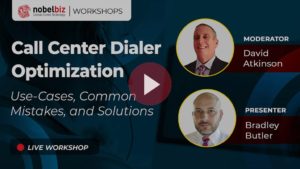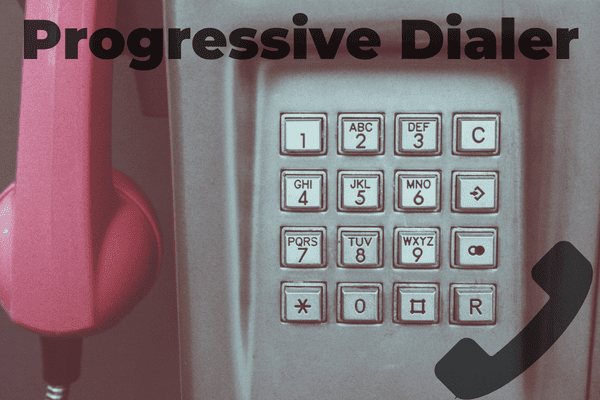In the contact center world, efficiency is paramount, hence the importance of progressive dialer software.
Every call center manager avidly searches for tools and methods to improve their contact center performance further and provide everything their agents need to achieve their highest productivity. And a progressive dialer is one way to achieve this.
With its inherent ability to automatically dial outbound calls to customers, allowing each agent sufficient time between calls, it skyrockets the number of calls daily and consequently contributes to the business’s success.
In this article, we distinguish progressive dialers from the rest of the dialers by going through information such as:
What is a Progressive Dialer?
How does a Progressive Dialer Works?
Factors to Consider When Choosing a Progressive Dialer Software
Best Practices for Implementing a Progressive Dialer into your Contact Center
What is a Progressive Dialer?
What is progressive dialing? A Progressive Dialer refers to a contact center software that automates outbound calling. It automatically dials a list of numbers and connects the call to an available agent when a person answers the call. Usually, the call to the following customer will be automatically started after a predetermined amount of time.
Unlike regular automatic dialers that dial multiple numbers simultaneously, progressive dialers have a slower pace. They dial one number at a time only when an agent is available to handle the call. This will allow agents more time between calls to document the interaction and properly prepare for the next call.
Progressive dialers are also equipped with features that improve the quality of outbound calling. Tools such as call recording, call routing and call analytics are useful in optimizing contact center operations and improving customer satisfaction.
The next section will elaborate on what makes a progressive dialer beneficial for contact centers.
How does a Progressive Dialer Work?
- The progressive dialer uses a list of numbers the contact center provides, usually in the form of a database generated from multiple sources, including lead lists or customer databases. Both are either purchased or collected.
- Secondly, the software uses algorithms to calculate the most convenient time to place the next call. Usually based on factors like the number of available agents, call success rates, and call history.
- When a call gets through, after confirming it’s a customer (and not a machine), the software connects it to the next available agent — presenting the agent with all the necessary information, such as contact name, history, and account details.
- In the occurrence of an unanswered call, the progressive dialer can leave a pre-recorded message or move on to the next number on the list. Depending on its fixed parameters.
- The software then tracks the metrics it was instructed to track and provides a full report to managers on call volume, duration, and success rates.
So now you know what a progressive dialer is and how it works. The next section will list the most important benefits of progressive dialer software and how it will benefit your contact center.
The Benefits of Progressive Dialers for Contact Centers
Increased Efficiency:
With their automatic capability, progressive dialers automate the dialing processes eliminating the need for manual work. This saves time and eradicates errors which leads to better call quality.
Additionally, progressive dialers prioritize calls based on factors such as customer history and agent availability. They also reduce the amount of time agents spend waiting for calls.
All of which increase the overall efficiency of contact centers. They allow more time for agents to focus on calls rather than waiting, improving conversion rates and reducing wait times while increasing productivity and calls dialed.
Enhanced Customer Experience:
Firstly, progressive dialers reduce the time customers wait for their calls to be answered. It also ensures that customers are connected to the right agent at the right time.
Additionally, a progressive dialer will assist agents by showing all the relevant customer information, such as customer history, feedback, and preferences.
This will help agents provide a more personalized and effective service with the ability to tailor their approach to each customer to provide a more engaging and relevant experience.
It also improves the customer’s perception of the contact center and curtails the likelihood of them hanging up before connecting to an agent.
Improved Contact Center Agent Productivity:
Progressive dialers allow agents to make more calls in less time, reducing their time between calls. It also ensures that agents spend more time talking to customers and less time handling administrative tasks.
Additionally, progressive dialers can prioritize calls based on customer history and agent availability. This ensures agents connect to the most auspicious leads, leading to higher conversion rates and results.
All these aspects help agents be more efficient and effective in their work by eliminating the need to select and answer calls manually. So that they can spend more time being engaged in productive work and less time waiting.
Better Call Quality:
Progressive dialers allow for better call quality by reducing the amount of unproductive time spent between calls. This reduces the likelihood of calls being dropped and awkward silences.
Additionally, progressive dialers automatically screen calls to detect busy signals, voicemails, and other undesirable outcomes that abate call quality.
Moreover, it enables agents to view customer data and call history before they answer the call.
All of this greatly improves call quality, ensuring agents connect only with customers ready to speak. This reduces the time spent on unproductive calls and elevates the quality of the interactions.
On top of that, it also allows agents to prepare for the interaction beforehand with the available customer data. This reduces the time spent on irrelevant or repetitive questions and ensures that agents are better equipped to handle the customer’s needs.
And finally, progressive dialers improve call quality by providing agents access to call scripts and recordings that assist them in delivering a more consistent and effective message. This improves the customer’s experience and increases the chances of a successful outcome.
Accurate Contact Center Reporting:
Progressive dialers possess tremendous reporting capabilities for call centers. They provide more accurate reporting by automating data collection processes, thus eliminating the risk of human error.
They also allow tracking metrics such as call volume, duration, and outcomes. Which helps managers gain a broader view of their operations.
Additionally, progressive dialers provide real-time data on the chosen KPIs. This also helps managers make informed decisions and swiftly respond to call volume shifts.
And finally, they provide customized reports tailored to your specific needs so that you can track metrics that are the most relevant to your business.
This will help in identifying areas where improvement is needed so that you can implement strategies to help the contact center achieve its objectives.
Overall, progressive dialer software is a valuable tool for contact centers that can help improve efficiency, productivity, and customer satisfaction. Now let’s explore how it works.
What to Consider When Choosing a Progressive Dialer for your Call Center
Progressive dialer software is essential for call centers, telemarketing companies, and other organizations that rely on outbound calling campaigns to reach customers. However, choosing such software must come from a place of reassurance, and the following is a list of factors to contemplate before making a choice:
Contact Center Call Volume:
In order to know which dialer is the most suited for your contact center, you need to consider call volume.
It refers to the number of calls an organization needs to make or receive in a certain period. Knowing your needs concerning call volume is crucial because multiple dialers have multiple capacities. Thus, it is important to ensure that the dialer can handle the volume of calls you need to make and also any future projections.
For example, if you need to make a large number of outbound calls, a progressive dialer with high capacity is recommended. However, a progressive dialer with strong routing capabilities would be more convenient if you need to receive a high volume of inbound calls.
Therefore, it is crucial to consider call volume when choosing a progressive dialer to avoid mishaps from intervening and ensure agents handle their calls efficiently for maximum productivity.
Integration:
Integration is the ability of a progressive dialer to connect and work flawlessly with other existing systems your organization is using.
Choosing software that integrates with other systems (ex., CRM software or contact center solution) you have implemented is crucial.
Cloud Contact Center Solutions are already equipped with progressive, predictive, and preview dialers, which makes it a convenient solution without a hassle.
Moreover, the integration will ensure a seamless data flow and allow smoother data transfers between the systems, reducing the need for manual labor and minimizing errors.
Integration also enables effective collaboration between departments and teams, consequently boosting productivity.
Call routing:
Call routing is the process of redirecting calls to specific agents or departments.
When choosing a progressive dialer software, make sure you know its routing capabilities to ensure that the inbound calls are handled effectively. This reduces wait times and improves their overall experience.
A progressive dialer with strong routing capabilities redirects calls based on a number of factors, including the caller’s ID, the purpose of the call, and the agent’s expertise and availability.
For example, if a customer is inquiring about a specific product or service, the routing systems will route the call to the most proficient agent in the matter.
Additionally, effective routing ensures that calls are not rerouted unnecessarily, reducing frustration and call durations.
Contact Center Compliance:
Compliance is one of the most critical factors when choosing a dialer, whether it is a preview, progressive, or a predictive dialer.

We discuss all-things dialers and how you can optimize them for maximum efficiency in our workshop episode Call Center Dialer Optimization: Use-Cases, Common Mistakes, Strategies, and Solutions
Outbound calls are subject to numerous regulations, such as the Telephone Consumer Protection Act (TCPA) and other applicable laws. Failure to comply will result in detrimental consequences for your organization and clients.
With our OMNI+, you don’t have to fret about compliance and regulations because that’s our job. You will be able to provide a worry-free and seamless experience to your customers without being pestered about whether you’re breaking the law.
Ensure that the software is compliant with all relevant regulations and that it has the necessary features to maintain compliance, such as:
- Caller ID: the ability to accurately display the organization’s phone number and name, as regulatory bodies require.
- Consent Management: features that allow organizations to collect and maintain customer opt-in and opt-out records.
- Do Not Call (DNC) list management: the ability to manage the national and internal DNC lists effectively, ensuring that no contact is established with numbers on the list.
- Call recording: the ability to record and store calls for compliance and training purposes.
Ease of use:
A difficult software solution will lead to frustration and errors and decrease productivity and job satisfaction.
Therefore, it is crucial that you choose software easy to use with an intuitive, user-friendly interface. This will allow agents to master the software, leading to a more productive workforce with minimal training required.
Moreover, the progressive dialer should be easily navigable to ensure quick and efficient use. It also should be easy to set up and configure with clear instructions, providing clear feedback to agents during interactions.
Finally, the software should act as a helping hand to agents, ensuring timely responses to inquiries and effective solutions for technical problems.
Cost:
The final and one of the most important factors is the cost of the progressive dialer software.
It is important to consider the cost of implementing such software and how it fits within the budget. You must ensure that you are getting a positive return on investment and that the software will bring value and meet your needs.
The cost will vary greatly depending on various aspects, such as the organization size and the number of agents using the software. Thus, it is decisive to predict the overall cost of adoption accurately including upfront costs, maintenance costs, and any additional costs.
Considering these factors, you can choose a progressive dialer software that best fits your business needs and helps you achieve your outbound calling goals.
The next section comprises some of the industry’s best practices for effectively implementing progressive dialer software.

Best Practices for Implementing Progressive Dialer Software
Conduct a Needs Assessment
A needs assessment is one of the most useful processes used in management. It helps to identify the gap between the current and desired states by determining which resources are needed and changes that need to be implemented to meet the fixed goals.
Here are some steps to properly conduct a needs assessment:
- Define the problem or opportunity: Through data collection, performance metrics review, and input from the relevant stakeholders.
- Identify the goals and objectives: Using the SMART method, ensure each goal is Specific, Measurable, Achievable, Relevant, and Time-bound.
- Determine the current state: Where your organization sits regarding the goals achievement journey. This can include reviewing policies, procedures, and practices and collecting stakeholder feedback.
- Identify the desired state: Once the current state is defined, you should determine what you want to achieve and what resources are needed to achieve it.
- Analyze the gap: between the current and desired state, pinpointing the improvement areas, how to remedy them, and which resources are needed.
- Develop an action plan: outlining the steps required to reach the desired state. The plan should comprise the human element, responsibilities, and timelines.
- Implement and monitor the plan to keep track of the progress and make adjustments as needed.
Choose the Right Software:
As we emphasized in the previous chapter, choosing a progressive dialer that integrates seamlessly with other systems, such as CRM systems and contact center solutions, is important to ensure higher productivity levels.
Train Your Agents:
Before the implementation, ensure that your agents are properly trained on the proper use of the software and how to handle the different types of calls. And, of course, how to provide excellent service in a professional manner.
Set Goals and Expectations:
Set realistic goals for your agents to enable progress tracking. Some used metrics include conversion rates, call durations, and CSAT scores.
Optimize Your Dialing Strategy:
By using data analytics, you can detect areas that need improvement. And practices that enhance productivity. This can include the best times of day to make calls, the most effective voicemail messages, and the most prominent time to follow up with leads.
Implement Quality Assurance:
Quality assurance measures such as call monitoring, recording, and scoring are helpful in ensuring that agents are providing excellent service.
Stay Compliant:
And finally, we can’t stress the importance of compliance enough.
Ensure the software fully complies with the latest law and regulations to avoid detrimental consequences from hurting your business and clients.
The Future of Contact Centers with Progressive Dialer Software
A progressive dialer, in addition to the predictive and preview dialers, is a valuable addition to your contact center. However, you must ensure that the pointers in this article are respected to avoid any undesirable consequences.
Or you can just adopt our omnichannel contact center solution called NobelBiz OMNI+ and be done with all the hassle of having to worry about compatible integrations or compliance issues.
With the recent breaches touching major companies, we can help you remain compliant with all the state and federal laws. Thanks to our Call Guard Ecosystem, we offer comprehensive dialing capabilities that help increase outbound call volumes in consent and non-consent scenarios while mitigating TCPA compliance risk perfectly.

Michael McGuire is a contact center industry expert with almost two decades of experience in the space. His experience includes roles as Director of Contact Center Digital Transformation at NobelBiz, and as Director of Operations at FLS Connect, managing multiple call centers. As President of Anomaly Squared and Targeted Metrics, Michael successfully transitioned companies into remote operations and significantly boosted revenues. With a strong background in customer service, leadership, strategic planning, and operations management, Michael excels in driving growth and innovation in the call center space.
Mike is also a proud Board Member for R.E.A.C.H Trade Group, promoting consumer protection and satisfaction and Co-host of the Off Skripted Podcast – a show about Life, Call Centers and everything in between.







